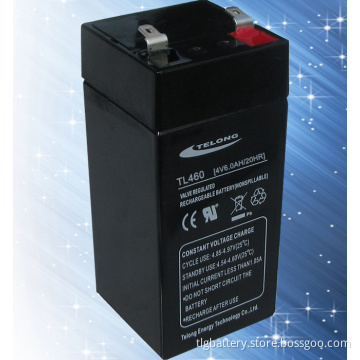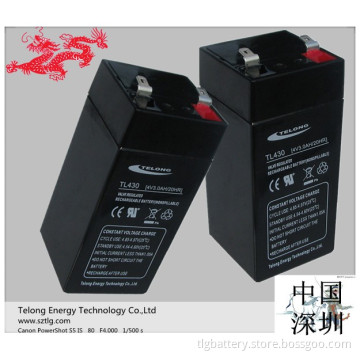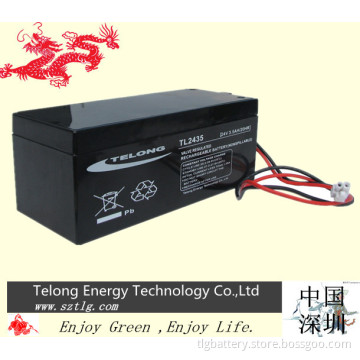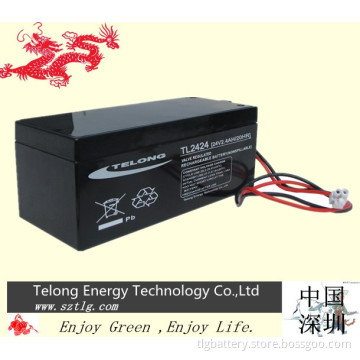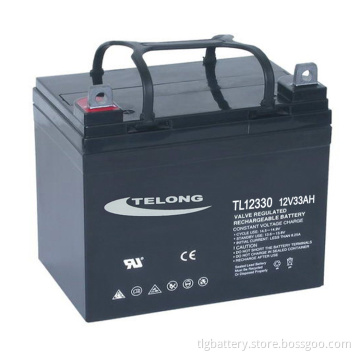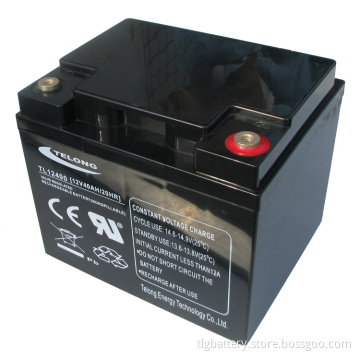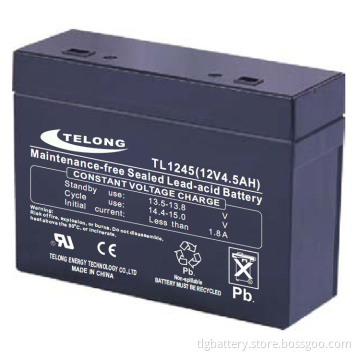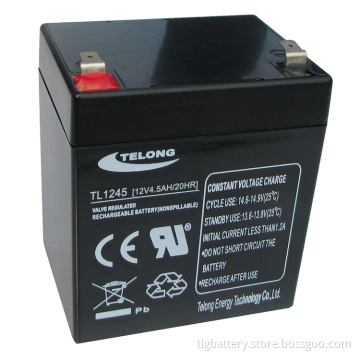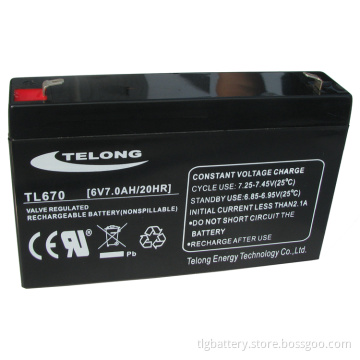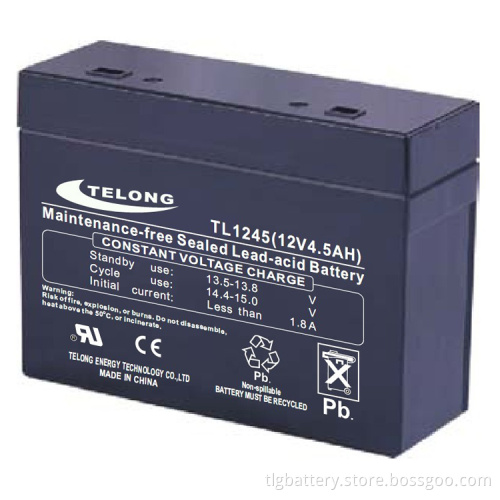
Lead Acid Storage Battery 12V 45ah for Car and UPS
- Payment Type:
- L/C, T/T, Western Union
Quantity:
Your message must be between 20 to 2000 characters
Contact NowBasic Info
Basic Info
| Place of Origin: | Shenzhen, China (Mainland) |
|---|---|
| Payment Type: | L/C, T/T, Western Union |
Product Description
Product Description
Applications
- Solar power system
- Wind power system
- Emergency lighting system
- UPS and emergency power supply
- Control system
- Medical equipment
- Telecommunication equipment
Features
- Maintenance-free lead acid battery
- Small internal resistance, high output power
- Up to 5 years service life
- Complete sealed (no liquid leakage, no acid gas spill)
- Low self-discharge rate, less than 3.5% per month
- Can be used any direction, easy to transport
- Good corrosion resistant performance and deep discharge recovery performance
Advantage
Choose Telong, and you will choose a good partner! You will benefit from:
- Lowest purchasing cost with no quality worry
- Premium quality with real no problem batteries
- Standard but perfect individual printing and packing
- Maximize your profit by ordering directly with us, the terminal manufacturer
- Professional OEM is available for your esteemed company
Question-Answer
1. What is the definition of "cycle use" and "standby use"?
"Cycle Use" - direct power source:
Cycle Use can provide the power supply to power tools, and portable electronic products. It can also be used for cycling charging and discharging usage such as electronics motorbike or vacuum cleaner.
"Standby Use" - back up power:
Standby Use is mainly used for emergency power to avoid future damage that may be caused by a sudden power outage.
2. What are the concerns when using Telong batteries in a parallel or a serial series?
- Do not mix brands, models and date codes.
- No separate discharge then charging in a serial configuration.
- Under parallel usage, pay close attention to the differences in voltage in each circuit.
- If the difference in voltage in each circuit is too high, do not charge/discharge as parallel.
- The environment of all circuits must be similar.
3. How can you check a battery's performance?
Different usage applications will use different methods for evaluating a battery's performance. Using a 20 hour rate or the 10 hour rate, you can use 0.05CA or 0.1CA to discharge the battery until the battery reaches a terminal voltage of 10.25 volts. You can then calculate the amp hours to see if the battery fits the specifications or not. For a 5 minutes rate, such as the HC1221W, you can use a 21 watts/cell discharge till the terminal voltage reaches a terminal voltage of 9.6 volts and then measure the discharge time to see if it meets the final specifications or not.
4. When should a deep-cycle battery be used?
Deep-cycle batteries are used when 50% or more of the capacity is used per cycle. The most common use of deep-cycle batteries is in applications that require deep, repetitive drain, like powerful car audio systems, trolling motors, golf carts, electric wheelchairs, or RV house power sources. Public safety and high-performance vehicles are other applications that call for the special characteristics of deep-cycle batteries.
5. Does the deep-cycle battery have a "memory"?
No. The performance of deep-cycle batteries will be reduced over time, but deep-cycle batteries do not suffer from "memory effect" such as NiCd batteries do.
6. How are batteries rated?
Lead acid batteries are rated based on a capacity given in a defined time. There is not a set industry standard for how to rate a battery.
7. How long can a battery last?
The service design life of a battery varies considerably with how it is used, how it is maintained and charged, temperature, among other factors.
8. What determines the life of a VRLA battery?
Sealed lead acid battery life is determined by many factors. These include temperature, depth and rate of discharge, and the number of charges and discharges (called cycles).
- Solar power system
- Wind power system
- Emergency lighting system
- UPS and emergency power supply
- Control system
- Medical equipment
- Telecommunication equipment
Features
- Maintenance-free lead acid battery
- Small internal resistance, high output power
- Up to 5 years service life
- Complete sealed (no liquid leakage, no acid gas spill)
- Low self-discharge rate, less than 3.5% per month
- Can be used any direction, easy to transport
- Good corrosion resistant performance and deep discharge recovery performance
Advantage
Choose Telong, and you will choose a good partner! You will benefit from:
- Lowest purchasing cost with no quality worry
- Premium quality with real no problem batteries
- Standard but perfect individual printing and packing
- Maximize your profit by ordering directly with us, the terminal manufacturer
- Professional OEM is available for your esteemed company
Question-Answer
1. What is the definition of "cycle use" and "standby use"?
"Cycle Use" - direct power source:
Cycle Use can provide the power supply to power tools, and portable electronic products. It can also be used for cycling charging and discharging usage such as electronics motorbike or vacuum cleaner.
"Standby Use" - back up power:
Standby Use is mainly used for emergency power to avoid future damage that may be caused by a sudden power outage.
2. What are the concerns when using Telong batteries in a parallel or a serial series?
- Do not mix brands, models and date codes.
- No separate discharge then charging in a serial configuration.
- Under parallel usage, pay close attention to the differences in voltage in each circuit.
- If the difference in voltage in each circuit is too high, do not charge/discharge as parallel.
- The environment of all circuits must be similar.
3. How can you check a battery's performance?
Different usage applications will use different methods for evaluating a battery's performance. Using a 20 hour rate or the 10 hour rate, you can use 0.05CA or 0.1CA to discharge the battery until the battery reaches a terminal voltage of 10.25 volts. You can then calculate the amp hours to see if the battery fits the specifications or not. For a 5 minutes rate, such as the HC1221W, you can use a 21 watts/cell discharge till the terminal voltage reaches a terminal voltage of 9.6 volts and then measure the discharge time to see if it meets the final specifications or not.
4. When should a deep-cycle battery be used?
Deep-cycle batteries are used when 50% or more of the capacity is used per cycle. The most common use of deep-cycle batteries is in applications that require deep, repetitive drain, like powerful car audio systems, trolling motors, golf carts, electric wheelchairs, or RV house power sources. Public safety and high-performance vehicles are other applications that call for the special characteristics of deep-cycle batteries.
5. Does the deep-cycle battery have a "memory"?
No. The performance of deep-cycle batteries will be reduced over time, but deep-cycle batteries do not suffer from "memory effect" such as NiCd batteries do.
6. How are batteries rated?
Lead acid batteries are rated based on a capacity given in a defined time. There is not a set industry standard for how to rate a battery.
7. How long can a battery last?
The service design life of a battery varies considerably with how it is used, how it is maintained and charged, temperature, among other factors.
8. What determines the life of a VRLA battery?
Sealed lead acid battery life is determined by many factors. These include temperature, depth and rate of discharge, and the number of charges and discharges (called cycles).
Related Keywords
Related Keywords
You May Also Like
You May Also Like

